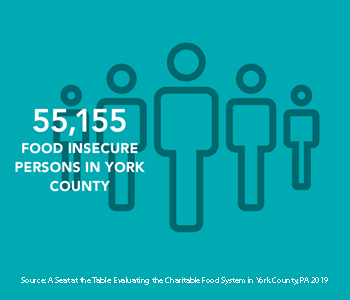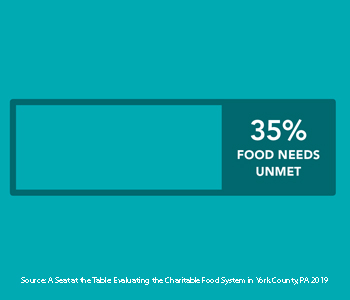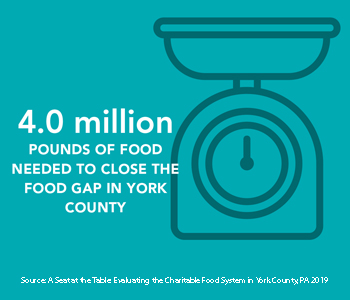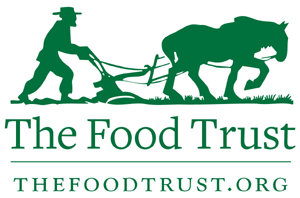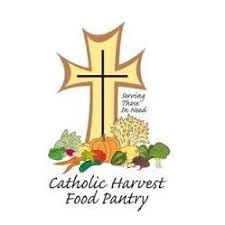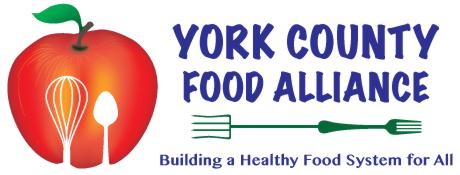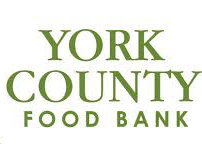A Seat at the Table
The complexity of food insecurity requires true collaboration – for organizations, funders, advocates and communities to cross boundaries, take risks and change their behavior to solve social problems.
In 2015, the Central Pennsylvania Food Bank announced the Bold Goal to End Hunger; which states that, by 2025, the Food Bank will provide enough nutritious food to everyone struggling with hunger in each of the 27 counties we serve. With the adoption of the Bold Goal, the Food Bank was intentional about access (everyone struggling with hunger) and food quality (nutritious food).
In 2016, Gov. Tom Wolf released “Setting the Table: A Blueprint for a Hunger Free PA.” This report identified strategies to close the meal gap with nutritious food, established goals, and charged the public and private sector with meeting the goals to end hunger by 2020 (see appendix for goals). These goals include establishing a food alliance in each county; increasing SNAP participation to 98% or higher; increasing free and reduced school meal participation to 30%; increasing school breakfast participation to 60%; increase Women, Infants, and Children (WIC) Farmers Market Nutrition Program redemption rates; making double SNAP bucks highly accessible at high need farmers markets; streamlining access to food security information and benefits; and improving access to healthy and nutritious food.
In 2017, the Memorial Health Fund announced a request for proposals to address social and physical health issues in York County, an opportunity to address food insecurity with an innovative approach. Catholic Harvest Food Pantry, the York County Food Alliance, New Hope Ministries, York County Food Bank and Central Pennsylvania Food Bank as the backbone organization aligned together and formed a collaborative to approach the opportunity from a collective impact lens, recognizing that no single organization could achieve the goal of a hunger-free York County. The group committed to move beyond partnerships, take risks, change behavior and assume shared responsibility to embrace collaboration. With the ultimate goal of implementing strategies identified in the Governor’s
Blueprint, York County has become one of the first in the Commonwealth to evaluate the charitable food network at a sub-county level. We want to demonstrate that when stakeholders within a system agree to assume shared responsibility, we can advance our missions, we can leverage our impact and we can
solve hunger.
In York County, more than 100 charitable food distribution programs exist and work hard to meet the needs of more than 55,000 people facing food insecurity, which requires 11.6 million pounds of food each year. However, many factors contribute to a significant gap in available resources, which means many still do not have access to nutritious food. This report focuses on further defining the need versus current resource allocation.
For a comprehensive look at our York County findings, please download our Final Report.
Across York County, rates of poverty and associated symptoms have steadily risen over the last 10 years. Food insecurity, like poverty, is a systemic issue requiring a change from the status quo. The complexity of food insecurity requires more than just partnerships, but rather true collaboration – and for organizations, funders, advocates and communities to cross boundaries, take risks and change their behavior to solve social problems. Collaborations depend on independent players agreeing to work together toward a common goal, a shared purpose. It is intentional and rigorous and is fueled by data.
The “A Seat at the Table” project’s intent was just that, collaborative: engaging partners by learning together from evidence-based data, around a common purpose, to achieve a shared goal — a hunger-free York County. What we know is that York County is home to more than 100 charitable food distribution programs, doing good work and helping neighbors. However, even with these programs there are thousands of people struggling with hunger and food insecurity. The USDA defines food insecurity as the lack of access to enough for an active, healthy life for all household members and limited or uncertain availability of nutritionally adequate foods.
With the support of the Memorial Health Fund, The Food Trust was commissioned, as an independent reviewer, to evaluate the charitable food distribution system using an innovative mapping approach to identify areas of need, draw attention to challenges, highlight successes, and make a clear call for systemic change to move the needle on food insecurity in York County. The Food Trust collected and analyzed data to produce the report, reviewing data from sources including Feeding America, the American Community Survey, the Central Pennsylvania Food Bank, the York County Food Bank, the U.S. Department of Agriculture and a survey distributed to the county’s charitable food providers. Analyzers evaluated each zip code by number of food insecure individuals, pounds of food needed per food insecure person per year, pounds distributed annually by the Central Pennsylvania Food Bank and the York County Food Bank and the pounds of food needed in each zip code.
Specifically, this report seeks to answer these questions:
- What areas in York County are most affected by food insecurity?
- What gaps are there in its food distribution system?
- How can we better coordinate and expand services to ensure that people living with food insecurity in York County get the help they need?
- What can be done to assure access to healthy and nutritious food for those struggling with food insecurity?
For answers to these questions and a comprehensive look at our York County findings, please download our Final Report.
There are many recommendations in the report. It will take the dedication from several stakeholder groups to bring these recommendations to fruition, including food banks and pantries, food system advocates, community partners, funders and policy makers.
We need to work together to re-align our efforts, because food is not distributed to areas most in need.
Recommendations include:
- Extended or weekend hours at food pantries
- Nutritious food offered following the national standard “Foods to Encourage” list
- Enabling client choice at food providers
- Sourcing food from local and regional food banks instead of purchasing at retail stores
- Facilitating alternative distribution models such as mobile pantries and pop-up markets
- Investigating the potential for improved distribution points near transit routes
- Leveraging ongoing training and support to collaborate county-wide
- Maintaining an online “food finder” database so those struggling with hunger can easily access services
- Developing a referral program so the food insecure can sign up at their local food provider for SNAP, WIC and school meal programs
- Encouraging existing retailers and farmer’s markets to become SNAP-authorized.
For answers to these questions and a comprehensive look at our York County findings, please download our Final Report.
Our Findings in York County: Detailed Maps (Click to download.)
Areas of Greatest Need by Zip Code
Food Insecurity Rate by Zip Code
Zip Codes with No SNAP Retailers
Priority Schools for Free and Reduced Meals Program Outreach
What is the report?
“A Seat at the Table: Evaluating the Charitable Food System in York County, Pennsylvania,” is a report identifying the state of the charitable food distribution system in York County. Using visual maps, it depicts areas of greatest need and areas where food distribution is robust, along with areas of high need where the food distribution must be improved. The report also contains recommendations to help support closing the 4-million-pound food gap in York County.
How did this report come about?
In 2015, the Central Pennsylvania Food Bank committed to its Bold Goal to End Hunger, which states, “By 2025, our collaborative network will provide access to enough nutritious food for everyone struggling with hunger in each of the 27 counties we serve, and we will convene and nurture partnerships to make progress toward ending hunger.”
In 2016, Gov. Wolf released “Setting the Table, a Blueprint for a Hunger Free PA.” This Blueprint challenged the Commonwealth to make systemic changes to improve charitable food distribution and access to food and nutrition programs for Pennsylvanians struggling with hunger.
The Food Bank’s focus has consistently been on how to best meet the needs of those struggling with hunger in our 27-county coverage area. After the release of the Governor’s report, and funding received from the Memorial Health Fund of the York County Community Foundation, the Food Bank formed a collaborative with several York County programs to conduct an environmental scan of the county’s charitable food program, producing a report closely examining what areas in York County are most affected by food insecurity, what gaps exist in its food distribution system and how we can better coordinate and expand services to ensure access to healthy and nutritious food.
Who put together this report?
The Food Trust, a third-party evaluator well versed in data collection and analysis related to food distribution, created the report and its recommendations. The Trust used data sources including Feeding America, the American Community Survey, the Central Pennsylvania Food Bank, the York County Food Bank, The U.S. Department of Agriculture and a survey of York County charitable food providers. They evaluated each zip code in York County by the number of food insecure individuals, the pounds of food needed per food insecure person per year, pounds distributed by the Central Pennsylvania Food Bank and the York County Food Bank, and the pounds of food needed in each zip code.
What are the key recommendations in the report?
The report addresses recommended changes for all stakeholders, including legislators, funders, community supporters, charitable food providers, food distributors, local transportation networks and volunteers. Recommendations all focus on updating the food distribution network and provider practices to avoid duplication in services and better address the areas of need in York County. They include extending hours, equitable distribution of nutritious foods, no retail food sourcing, creating mobile pantries and investigating better distribution points near transit routes. These recommendations also include encouraging retailers and farmer’s markets to become SNAP (Supplemental Nutrition Assistance Program) -authorized and developing a robust screening and referral program so providers are encouraging participation in SNAP, Women Infants and Children (WIC) and child nutrition programs like free and reduced school breakfast and lunch.
What role will the Central Pennsylvania Food Bank be taking on in relation to this report?
Our organization will encourage and support collective impact strategies and will be the backbone for providing communications, education, training and leading public discourse on how to implement the recommended changes in the report for York County. You’ll see our leadership, staff, board, donors and volunteers all playing a role in making sure the concrete data and recommendations are acted upon, and we’ll be taking those lessons and applying methodologies in the report to all the communities we serve.
How will this affect other counties the Central Pennsylvania Food Bank distributes to?
The learnings and practices recommended will be recognized in counties across our footprint. We can take this opportunity to encourage our other county partners to evaluate their own gaps and how to improve them and assist in closing the hunger gap in all 27 counties we serve.
Will the Central Pennsylvania Food Bank be initiating more reports like this for the other counties it works in?
At this time, we do not have plans to directly invest in or lead an effort in a specific county; however, the Central Pennsylvania Food Bank remains committed to our Bold Goal to End Hunger, so we will continue to capitalize on opportunities to support that goal as they arise across our entire service area. We’ll take the learnings from this report and continue to create meaningful change across the communities we serve.
Who do I contact for more information?
For more information on the report, please contact the Central Pennsylvania Food Bank at 717-564-1700.
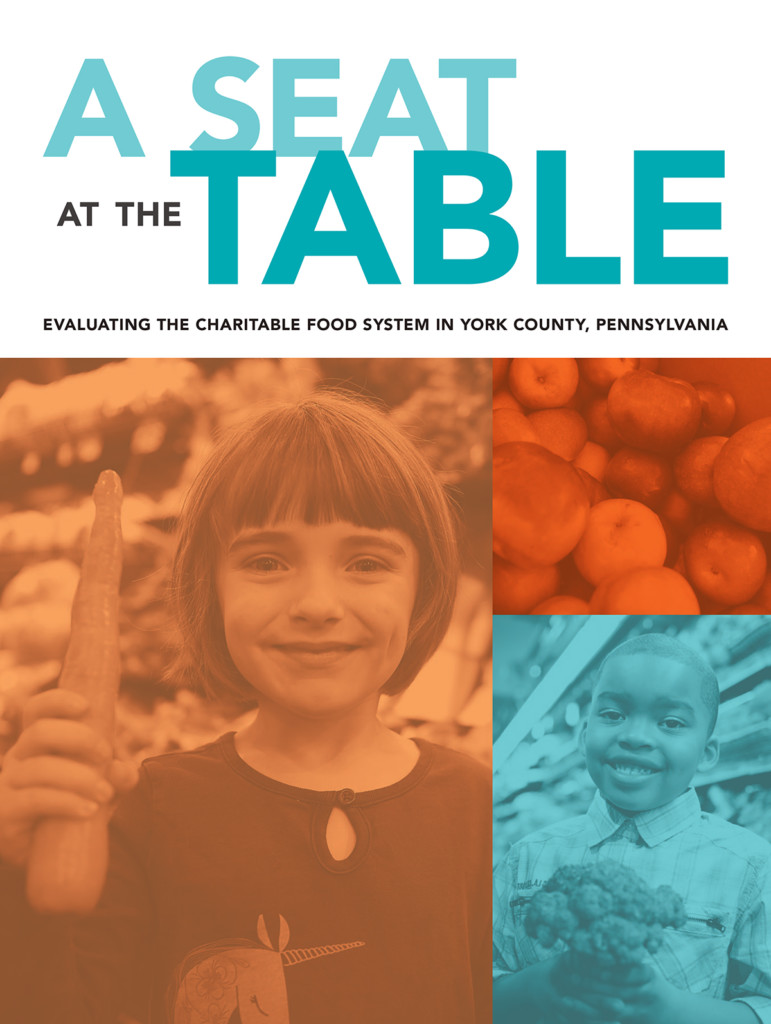
York At-A-Glance
